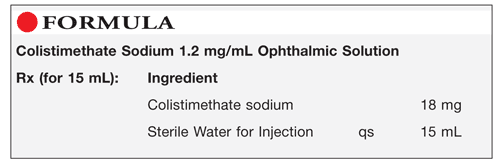
Method of Preparation: Note—this formulation should be prepared according to strict aseptic compounding technique in a laminar airflow hood in a cleanroom or via isolation barrier technology by a compounding pharmacist who is validated in aseptic compounding. This is a low-risk preparation.
Calculate the quantity of each ingredient for the amount to be prepared. Accurately measure each ingredient. Reconstitute the colistimethate for injection with 2 mL of Sterile Water for Injection, producing a 75-mg/mL concentration of the drug. Gently swirl the solution to mix and to avoid frothing. Remove 0.24 mL of the solution; add sufficient Sterile Water for Injection to 15 mL and mix well. Package appropriately and label.
Use: Colistimethate ophthalmic solution has been used for the treatment of ophthalmic infections that are sensitive to colistimethate.
Packaging: Package product in tight, light-resistant containers.
Labeling: Shake well before use. Keep out of the reach of children. For the eye. Discard after 24 hours.
Stability: Use this preparation within 24 hours.1
Quality Control: Quality-control assessment may include weight/volume, physical observation, pH, specific gravity, osmolality, assay, color, clarity, particulate matter, and sterility.2,3
Discussion: Colistimethate ophthalmic solution has been used in the treatment of infections caused by sensitive strains of certain gram-negative bacilli that are resistant to other antibacterial agents; it also may be used in patients who are allergic to other antibacterials. A commercially available colistimethate sodium injection, Coly-Mycin M Parenteral, contains the equivalent of 150 mg colistin base as colistimethate sodium per vial for injection.1
Also available is a Coly-Mycin S Otic that contains colistin sulfate 3 mg/mL, hydrocortisone 1%, neomycin sulfate 4.71 mg, and thonzonium bromide 0.05%/mL, along with polysorbate 80, acetic acid, sodium acetate, and thimerosal. It occurs as a suspension and is packaged in 5-mL and 10-mL dropper bottles.4
For inhalation, the Coly-Mycin M Parenteral vial may be further diluted to a total volume of 3 mL to 4 mL in normal saline and administered via nebulizer.
Colistimethate sodium (colistin sodium methanesulfonate, C58H105N16Na5O28S5 [colistin A component], MW 1749.82; C57H103N16Na5O28S5 [colistin B component], MW 1735.79)5 occurs as a white to slightly yellow, odorless, fine powder that is freely soluble in water and slightly soluble in alcohol. The pH of the reconstituted solution is between 6.5 and 8.5 in a solution containing 10 mg/mL. Protect colistimethate sodium from light.5-7 Colistimethate sodium is prepared from colistin by the action of formaldehyde and sodium bisulfite. The potency is not less than 390 mcg of colistin per milligram.
Sterile Water for Injection is water for injection that has been sterilized and suitably packaged; it contains no added substances. Sterile Water for Injection has been purified by distillation or by reverse osmosis. Note that Sterile Water for Injection is not prepared by an ion-exchange process. The term “water” is used to describe water from a public water supply that is suitable for drinking and is the beginning point of the official waters; it is a clear, colorless, odorless, and tasteless liquid. Purified water is water that is obtained by distillation, ion exchange, reverse osmosis, or some other suitable process. Water has a specific gravity of 0.9971 at room temperature; it has a melting point of 0°C and a boiling point of 100°C. Water is miscible with most polar solvents, and it is chemically stable in all physical states (ice, liquid, and steam).8
REFERENCES
1. Lacy CF, Armstrong LL, Goldman MP, Lance LL. Lexi-Comp’s Drug Information Handbook. 13th ed. Hudson, OH: Lexi-Comp, Inc; 2005:374.
2. Allen LV Jr. Standard operating procedure for particulate testing for sterile products. IJPC. 1998;2:78.
3. Allen LV Jr. Standard operating procedure: quality assessment for injectable solutions. IJPC. 1999;3:406-407.
4. Billups NF, Billups SM. American Drug Index. 55th ed. St. Louis, MO: Wolters Kluwer Health; 2010:217.
5. USP Dictionary of USAN and International Drug Names, 2010. Rockville, MD: US Pharmacopeial Convention, Inc; 2010:243.
6. USP Pharmacists’ Pharmacopeia. Rockville, MD: US Pharmacopeial Convention, Inc; 2005:138,408-413,1432,1448.
7. Sweetman SC, ed. Martindale: The Complete Drug Reference. 36th ed. London, England: Pharmaceutical Press; 2009:256.
8. Dubash D, Shah U. Water. In: Rowe RC, Sheskey PJ, Quinn ME, eds. Handbook of Pharmaceutical Excipients. 6th ed. London, England: Pharmaceutical Press; 2009:766-770.
To comment on this article, contact rdavidson@uspharmacist.com.





